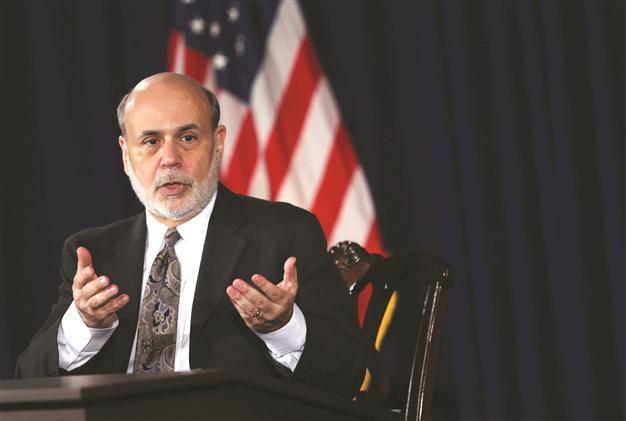US Fed cuts bond buying in first step away from historic stimulus
WASHINGTON - Reuters

Federal Reserve Board Chairman Ben
Bernanke speaks during a news conference after a Federal Open Market Committee (FOMC) meeting on Dec 18 at the Federal Reserve in Washington, DC. AFP photo
The Federal Reserve has embarked on the risky task of winding down the era of easy money, saying the U.S. economy was finally strong enough for it to start scaling down its massive bond-buying stimulus.
The central bank modestly trimmed the pace of its monthly asset purchases, by $10 billion to $75 billion, and sought to temper the long-awaited move by suggesting its key interest rate would stay at rock bottom even longer than previously promised.
At his last scheduled news conference as Fed chairman, Ben Bernanke said on Dec. 18 that the purchases would likely be cut at a “measured” pace through much of next year if job gains continued as expected, with the program fully shuttered by late-2014.
The move, which surprised some investors but did not cause the market shock many had feared, was a nod to better prospects for the economy and labor market. It marked a historic turning point for the largest monetary policy experiment ever.
“The recovery clearly remains far from complete,” Bernanke said. But “we’re hopeful ... we’ll begin to see the whites of the eyes of the end of the recovery, and the beginning of the more normal period of economic growth.”
Bernanke said he consulted closely on the decision with Fed Vice Chair Janet Yellen, who is set to succeed him once he steps down on January 31 after eight years at the helm. “She fully supports what we did today,” he said.
Investors took the action as a validation that the outlook for the economy was improving. After a brief pullback, U.S. stocks rallied sharply, with both S&P 500 and Dow industrials closing at all-time highs. At the same time, U.S. Treasury bond prices fell, but the move was modest, capped by the Fed’s strengthened commitment to keep interest rates near zero for a long time irrespective of the reduction in its asset purchases.
The Fed said monthly purchases of both mortgage and Treasury bonds would be trimmed by $5 billion each, starting in January.
“This is a modest change, not a big one, and it shows that they are not in a rush,” said Scott Clemons, chief investment strategist for Brown Brothers Harriman Wealth Management.
End of an eraThe Fed’s extraordinary money-printing has helped drive stocks to record highs and sparked sharp gyrations in foreign currencies, including a drop in emerging markets earlier this year as investors anticipated an end to the easing.
“They finally pulled a Band-Aid off that they’ve been tugging at for a long time,” said Rick Meckler, president of hedge fund Liberty View Capital Management in Jersey City, New Jersey.
The Fed launched its third and latest round of quantitative easing, or QE, 15 months ago to kick-start hiring and growth in an economy recovering only slowly from the recession. Its first program was launched during the 2008 financial crisis. The central bank’s asset purchase programs, a centerpiece of its crisis-era policy, have left it holding roughly $4 trillion of bonds, and the path it must follow in dialing it down is rife with numerous risks, including the possibility of higher-than-targeted interest rates and a loss of investor confidence.
To soothe investors’ nerves, the Fed said it “likely will be appropriate” to keep overnight rates near zero “well past the time” that the jobless rate falls below 6.5 percent, especially if inflation expectations remain below target. The Fed has held rates near zero since late 2008.
Expectations on ratesIn fresh quarterly forecasts, the central bank lowered its expectations for both inflation and unemployment over the next few years, acknowledging the jobless rate had fallen more quickly than expected. It now sees it reaching a range of 6.3 percent to 6.6 percent by the end of 2014, from a previous prediction of 6.4 percent to 6.8 percent.
Three policymakers expect the first rate rise to come in 2016, up from only two in September, while 12 of the Fed’s 17 top officials still see the move in 2015. Futures markets do not see better-than-even odds of a rate hike until September 2015.
